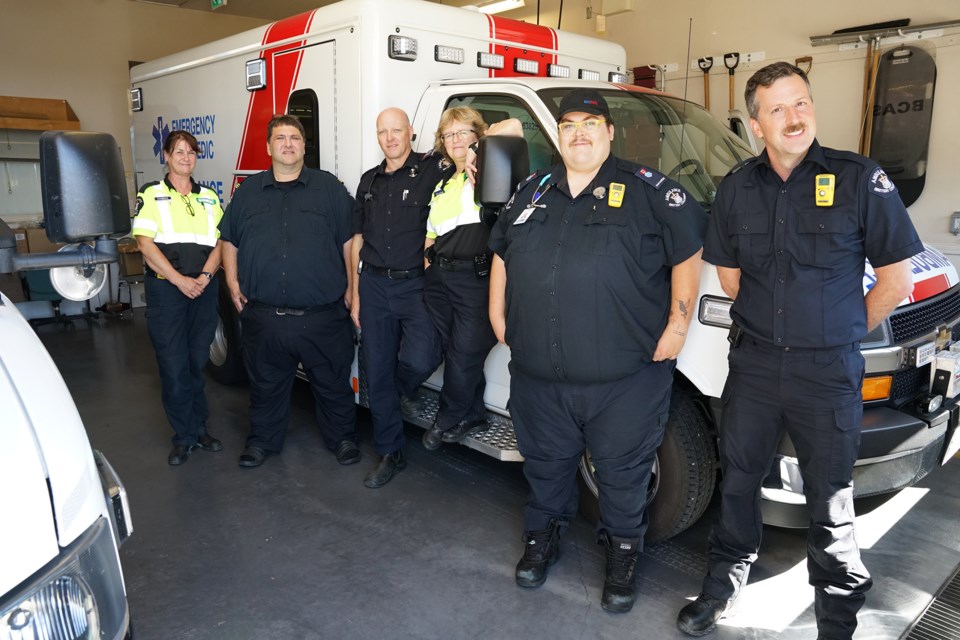While shortages of trained paramedics have been making headlines around the province, innovative solutions are being found locally.
Powell River Fire Rescue (PRFR) chief Terry Peters said Powell River is no exception to what is going on in the province, and across the country, for that matter. Peters said local Emergency Health Services unit chief Terry Dyer reached out looking for help and staffing from the fire department.
“He talked with us,” said Peters. “We’ve always had a good relationship with our ambulance service and all emergency services. Because we are first responders, we work in conjunction with them.
“If you’ve got an issue, chances are you’ll see a fire truck and an ambulance.”
Peters said the qathet region is covered for fire protection by PRFR, Malaspina Volunteer Fire Department and Northside Volunteer Fire Department. He said the ambulance service covers it all.
“They could have to go to Lund, they could have to go to Saltery Bay – their call volume is larger than ours,” said Peters. “They are running all the time. They are a very busy service. Delays are common, as they are everywhere else.
“With their staffing, and the shortage of ambulance personnel, they are looking for staff. It’s just natural to reach into the fire services.”
Peters said by allocating help from the three fire departments, it taps into the fire service resources, because all emergency services are drawing from the same pool.
“I’ve got three staff, one career and two auxiliary staff, who have actually stepped up and worked with the ambulance,” said Peters. “You’ll actually see firefighters driving ambulances now and being paramedics.
“Hopefully, that is going to lessen the staffing burden. It isn’t a complete solution. The ambulance service still needs paramedics so we are working to help alleviate some of those concerns.”
Getting creative
Peters said before he was a firefighter, he came from the ambulance service, and he was a firefighter/paramedic when he started into his current occupation.
“It’s kind of gone full-circle,” added Peters. “Now, we are dipping into other resources just to fill the void. In a small community where we are, you have to be creative with your resources to provide the services we provide.
“For us, being an isolated community, it has its challenges.”
PRFR has precedent for allocating human resources to other operations. Peters said during the height of the pandemic, qathet General Hospital reached out to the fire department, realizing that because of some of the training that has been done in the hospital, that firefighters provide a number of skill sets outside of being firefighters.
“We have all sorts of people who have skills that can be beneficial in the hospital, so they reached out to us and we had a team of our auxiliaries who did some training in the early stages of the pandemic,” said Peters. “If hospital staff became sick or maybe were allocated to another hospital, the firefighters would have gone in and made sure that the doors remained open and they kept our hospital running. That is the depth of response we have in our community.
“If things go wrong in the community, we’re there to help.”
Peters said he has pride as the fire chief, knowing that the staff, no matter what happens, can be responsive.
He said fire department staffing, however, is not what it once was. When he started, there were fire halls in Wildwood, Cranberry and Westview, and there were 25 auxiliaries in each, in addition to career firefighters. He said career staff were up to 18. He said there are now fewer than 20 paid on-call auxiliaries and 12 career firefighters, and three working on flex to cover off overtime and other situations.
“Our call volume is more than it has ever been,” said Peters. “Back in the 1990s we had 500 to 600 calls per year. We are now 1,000 calls on average. We are doing more calls with less staff.
“Paramedics also have far more calls than they have done before, too.”
Peters said assisting the ambulance service is not a full-time solution but sharing resources is important, even if they are spread thin.
Integrated first responders
Dyer said the ambulance service has been integrating firefighters from PRFR, Malaspina and Northside volunteer departments into its ranks.
“We definitely have been short-staffed for the last year or so,” said Dyer. “Having the firefighters come on board is a huge teamwork type of good news story.
“It’s certainly helping out. We are still understaffed and we are nowhere near full complement but we are keeping at least one ambulance running 24 hours a day. Probably 80 to 90 per cent of the time, we have two ambulances staffed during the day.”
The ambulance service here is very busy. Dyer said it is an isolated station with 3,000 to 3,500 calls per year.
“We’re quite lucky to have the extra help,” added Dyer.
He said the local unit is classified as a primary care paramedic station. Up until last year, there were no paramedics with less than that designation, but because the service is so short-staffed, it has been opened up to people with emergency medical responder qualification and a class four driver’s licence, he added.
Staff shortages are not unique to the qathet region, according to Dyer. He said the problem is playing out not only province-wide, but nation-wide. He said he has spent time on the east coast in Prince Edward Island and New Brunswick and they are “just hurting” for paramedics, as well as for other health-care workers.
“A lot of the hospitals and clinics in New Brunswick and PEI are actually closing because they don’t have staff, and that’s happening in BC, too,” said Dyer. “We’re lucky our hospital hasn’t come to that.”

.jpg;w=120;h=80;mode=crop)

